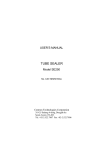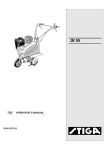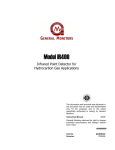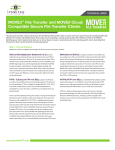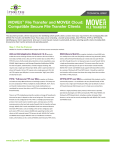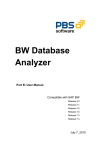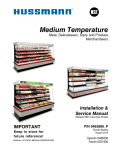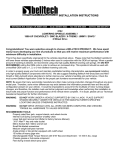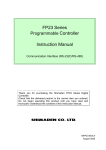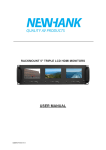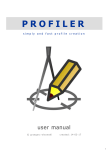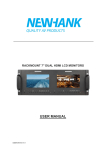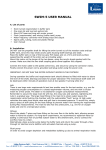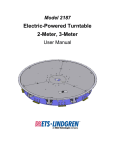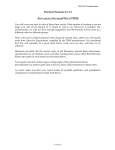Download Chapter 6 Fish Systems
Transcript
Chapter 6 Fish Systems The fish facility at present has 10 separate fish system between the 3 laboratories H221, J083b, and G617. These systems are the foundation of the research performed with the fish they house and maintenance of them is of utmost concern. Therefore no personnel should perform maintenance on any fish system filtration with out the approval of the facility manager. The systems range in size from 1000 gallons to 30 gallons and all but one is a recirculating water system. Generally, a recirculating water system works by taking drainage water from fish tanks and pumping it through some type of biological filter that contains bacteria capable of removing toxic fish waste, next the water is pushed through a mechanical filter, often woven nylon or polyester to remove large mostly organic debris, then the water is passed through activated carbon media to remove smaller predominately non-polar organic waste, and finally through a ultraviolet (UV) sterilizer that is capable of neutralizing algae, mold, spores, protozoa, bacteria and even some viruses before the water is delivered back to the fish tanks. The types of and sizes of these filters depend on the size and style of the fish system. As a general rule of thumb the biological filter is placed where the water is dirtiest and the UV is located where the water is the cleanest. The one non-recirculating fish system is located in the quarantine room. This fish system uses a single-pass method to insure fish tank water is not reused in other tanks. For more information on this system and quarantine room procedures please see Chapter 9. 6.1 Daily Maintenance Regardless of the type of fish systems the following categories must be addressed on a daily basis. Water must be flowing in adequate quantities to all fish tanks. This water needs to be able to drain out of the tank properly either by baffle, bulkhead or screen plug. Finally, the water quality must be with in specific parameters and if not it must be adjusted. The intent of this chapter is to show people how this can be done on all of the different types of fish system found in the facilities. 6.2 Aquatic Habitats General In the H221 laboratory the Aquatic Habitat Fish System (AH) occupies the entire northwall. It is composed 5 5’-AH racks, 4 3’-AH racks and 2 4’-Zebrafish modular units (Marine Biotech). It has a total water capacity of 3730 L (927 gal.) with available tank sizes of 1.5 L, 2.0 L (Zmod only), 2.8 L, and 9.0 L. The 2.8 L and 9.0 L tanks are interchangeable as are the 1.5 L tanks with the appropriate manifold. All fish tank water lines have individual adjustment valves on the manifolds above the tank. The total number of tanks varies greatly depending on the tank sizes and arrangements being used, but it commonly supports 350-400 tanks. AH tanks must be used with appropriate lids and baffles. A 2 HP Baldor pump draws water from the sumps and delivers it to two canister bag filters. The first canister is a particle prefilter with a 50 micron felt bag filter, the second canister is a 50-micron bag filter with carbon and coral media. Water is then sterilized by a 390 watt UV (6-65 watt bulbs) before entering the fish tanks. Water from the fish tanks drain down a gutter and passes through a polystrand filter before entering the sump below the fish rack. Water in the sump J K M moves through a Siporax biological H G filter and is aerated by diffuser I powered by an air pump above the canister filters, see figure 6.0. Water D is then drawn back to the pump. The system generally runs at 35-45 gpm. E F The system receives a 5% water exchange (~50 gallons) from the C water tower every day via a timer, metering pump, and solenoid valve A system located next to the water B tower. The timer turns on at 10:00 Figure 6.0 A) Valve connecting the sump to the pump. AM off at 12:00 PM. Maintenance B) Pump C) Valve to prevent back flow during pump replacement. D) Canister shut off valve #1 E) Prefilter canister. F) Carbon filter canister. G) System bypass valve. H) Canister shut off valve #2. I) Filter bypass valve. J) Low-level pump shut off relay box. K) Air pump platform. L) Pressure gauge. M) Pump power switch. Daily Water Flow and Drainage. On a daily basis individual tanks are inspected by staff to insure adequate water flow and proper drainage. Smaller tanks (1.5 L-2.8 L) have a single water line while larger 9.0 L tanks have two. Each tank needs a water exchange of 6 turns an hour (6 times the water volume of the tank). This can be accomplished by adjusting the tanks water supply valve(s) to a steady but not brisk stream of water. Brisk streams of water can overflow the tank possibly leading to fish loss. Tanks with too little or no water supply can produce toxic levels of waste. Baffles located at the back of the tank need to be inspected for excessive biofluc buildup that can inhibit drainage. If the tank baffle is clogged lift the back of the fish tank lid (avoid startling the fish) and with the baffle still seated at the bottom of the tank wiggle the top of the baffle front to back. If this does not clear the debris switch out/install a new tank, see Tank Use below. Sumps. Also on a daily basis top off sumps with system water each sump is marked indicating where the water level needs to be. Lids. Once a week the lids should be wiped down with 70% isopropyl alcohol. Spray isopropyl on to a paper towel and clean the fish tank lid. Be careful not to push any of the debris on the lid in to the tank. Weekly Canister and sump filters along with carbon media need to be replaced weekly. Maintenance is typically performed with the system running. Sump Filters Sump prefilters are located just below the vertical L drainpipes on each rack and are suspended above the sump water by a shelf. They are collected by pulling out and lifting them off the filter shelf. The dirty filters are then placed in a labeled disinfection bucket see disinfecting filters at the end of this chapter. Obtain clean sump prefilter pads from the shelve above the sink and place them back on to the sump filter shelf. Make sure they are situated under the draining water from the fish rack. Canister Maintenance o Just before maintenance record on the maintenance log the pressures from gauge 1,2, and 3 and the reading from the flow meter, all of which are labeled. o Make sure the filter bypass valve (I) is completely opened. o Slowly and simultaneously close the two canister shutoff valves (D and H). Make sure that the pressure gauge (L) does not exceed 25 pounds per square inch (psi) while closing these valves. o Open the air breath knobs located on the tops of both canisters lids (bronze color with black knob). o Attach a plastic hose to the barbed outlet with valve at the bottom of either canister. Place the other end of the hose in to an empty bucket. o Open the barbed outlet valve. Water from the canister should drain in to the bucket. If not tilt the bucket and plastic hose down towards the ground. Water drains from the canister by gravity. If this still does not work try turning the canister lid counter-clockwise (open) to relieve any pressure. o Drain the second canister. Open both canister lids by turning them counterclockwise. As the lids comes off be careful not to loose the large black o-ring under each lid. o Set the lids and o-rings aside for the time being, and empty the drainage bucket. o With the freshly emptied bucket nearby and lift out to the bag filters inside the canisters and place them in to the bucket. With plastic hose still connected to the o o o o o o o o opened barbed valve briefly rinse out both canister with RO and take the soiled filters to the sink. Lift out the carbon and coral media bags out of the canister bag filters. Place the canister filter bags in to disinfection buckets see filter disinfection. Empty the carbon in to the garbage can and wash off both the empty carbon bag and the coral bag with the coral still in it. Obtain a bucket of fresh carbon from H225 and get the carbon strainer bucket (short white bucket with numerous holes drilled through it). Inside the strainer bucket there is a horizontal line fill the strainer bucket with fresh carbon to this mark. Set the strainer bucket in to the sink and thoroughly rinse the carbon with RO water. Allow to dry somewhat in the sink. Collect two new bag filters from above the sink. Place one each into each canister. Get a large funnel and place it in the second (F) canister, the carbon media one. Pour the washed carbon from the strainer bucket through the funnel in to the bag filter. Place rinsed coral bag back in to the canister. Clean the canister lids with 70% isopropyl and a paper towel. Wipe off o-rings with a paper towel and relubricate them with Teflon lubricate. Place the one ring in the groove inside the canister just inside the threaded portion at the top. Repeat for the second canister. Set the canister lids back on top and turn them clockwise until they are snug. Hand tight will be sufficient. Make sure the barbed drain valves at the base of each canister are closed and the air breathers are still open. Slowly and simultaneously open the two canister shutoff valves (D and H). As water rushes in to the canisters displaced air will whistle out the breathers. When the whistling stops turn the air breather knobs clockwise to close them. There will also be whistling noise from the pressure relief valve (not shown), which is above and to the left of the canisters. This is normal. Slowly close the filter bypass valve (I) until the pressure gauge (L) reads 15 psi. Record the maintenance procedures in the maintenance database on the H225 computer. Also, under comments on the water quality sheet hanging on the fish system rack write “maintenance”. Every Six Months or as needed Clean out drain gutters and manifolds. Gutters and manifolds are removable from this system. Remove Siporax biofilter panels from the sumps and rinse them off with RO. Every Nine Months Replace U.V. bulbs. System has U.V. controller box that has illuminated indicator of bulb function and timer, see directions U.V. at the end of this chapter. Every Year or as needed Disinfect shelves with isopropyl alcohol. Have the system pump serviced at a motor shop. Tank Use A Clean tanks, lids and baffles can be found along side and above the sink in H221. There are two types of baffles. The blue ones are for large adult fish ~90 days old while the transparent ones with the mesh screening are for younger fish. The blue baffles sit off the bottom of the tank when installed, so if the fish are small enough to go through this gap or if you’re uncertain, use the transparent baffle. These baffles sit flat across the bottom of the tank, no gap. Slide the baffle in to the back of the tank making sure the baffle sits freely on to the bottom of the tank. The transparent baffles have a groove on the outside edge that needs to face the back of the tank. Make sure these baffles slide all the way down to the bottom of the tank. Both types of baffles should fit smoothly in to the tank, you should not have to use significant force to install them if you are your probably installing them wrong, and should ask for help. If your putting fish in the tank fill it ¼ full with system water, and place the fish in to the water. Place or transfer any identifying labels to the front upper left hand corner of the tank and create a small white label with date the tank was installed on to the system and place it on near the bottom left corner of the tank. Install the lid it sits down slightly with in the tank so that the lid is flush with the rest of the tank. The tabs/handles should fit over the side of the tank. The bottom outside of the tank has 2 sets of cleats that fit over the steel bars of the fish rack. Lift the tank in to place making sure the drainage pipe rests above the drain gutter and the cleats are parallel and rest over the supporting steel bars. Install the water line(s) in to the small hole in the lid near the front. Open the water valve(s) until a steady but not brisk stream of water enters the tank. To clean a tank shutoff the water valves and remove them from the tank. With the tank still in place lift the front of tank to drain water out the back of the tank. Additional water can be removed from the tank if need be by siphoning with a rubber hose with a screen attached to the intake to prevent fish from being sucked up. Water from the siphon can be drained in to a bucket, and emptied in to the sink. Lift the tank up high enough to clear the gutter at the back and pull out the tank. Transfer the fish to a clean tank as described above. Take the dirty tank to the sink remove the lid and baffle and empty out any remaining water. Thoroughly rinse the tank and accessories with RO water, and place it in the bleach bath or on the dirty dish cart. Adjusting Water Quality The following is also posted on a green tag hanging on the fish system rack. To adjust pH: pH> 6.95, no adjustment needed pH: 6.95 > pH > 6.75, add 300 ml 1 M sodium bicarbonate solution pH: pH < 6.75, add 400 ml 1 M sodium bicarbonate solution Figure 6.1 A) Aquatic habitat tank with adult baffle properly installed. B) AH tank properly installed on fish rack. To adjust Conductivity: 1500 µs, no adjustment needed Conductivity > 1700 µs, 100 gallon RO water exchange Conductivity < 1300 µs, add 200 ml super saturated salt solution to the sump. The AH system has an overflow drain. To perform a manual water exchange to bring down the conductivity slowly overfill the sump to the desired volume with RO water. The flow rate of the RO water will need to be known and the water exchange has to be timed. Safety Features & Emergency Shutdown The AH system has a float-switch pump shutdown in the sump adjacent to the pump that is controlled by the black relay box (I in Figure 6.0) located just above the filter canisters. During times of low water levels in the sump the pump will shut down to avoid drawing air in to the pump that could lead to gas-bubble disease in the fish. For this system to work the pump has to be plugged in to the relay box and the float switch needs to be properly adjusted, set to shut off before the water level in the sump reaches the intake of pump. In tandem with this feature is the auto-fill system that is driven by the system water tower pump and controlled by a float switch in the sump adjacent to the pump. If the water level in the sump drops the switch will open allowing the sump to fill with system water from the tower. For this feature to work the water tower pump most be running and the float switch needs to be properly adjusted. This system should be tested periodically for proper function. For adjustments to these systems see the Aquatic Habitats user manual located on the shelf in H225. In case of emergency the switch located on the float-switch relay box can shut down the system. Warning, shutting down the system will most likely flood the sumps to avoid this turn the overflow drain downward. The drain is located across from the auto-fill float-switch downward. 6.3 Aquaneering General The current Aquaneering fish system (AQ) is in the J-083b next to the cement column to the right as you enter the laboratory. This 170-gallon (653 Liter) 6-shelf stand-alone fish system offers 1.5 L, 2.8 L and 9.0 liters tanks that are interchangeable on the rack (the 1.5 L tanks with appropriate manifold). The system typically holds 62 tanks, but this varies. Most of the filtration package on this system is submerged. The AQ multirack system, currently under construction, occupies the entire southeast section of J-083b lab and when completed will have a total volume of 1008 gallons (3877 Liters) with 600 tanks of various sizes (1’s, 3’s and 9’s). Each tank has individual water flow control valves on the manifold above the tank. AQ and AH fish systems are very similar to each other, even to the point were their tanks can be interchanged between the two fish systems, but tank accessories (baffles and lids) are not. For this reason it is not allowed to interchange tanks between the systems. AQ fish tank accessories are green while AH are blue. Future expansion plans call for more and larger multi-rack AQ systems. Stand-Alone. Water is drawn in through 2 carbon filters wrapped in10 µm Dacron in to the fish rack pump. From here the water is pumped to the top of the rack where it is sterilized by a 40-watt U.V. before entering the tank manifolds. Waste water drain out the tanks into gutters and then through a 10µm Dacron pad in the sump. From here a biofilter pump moves the water to the bottom of a sand biofilter. The water up wells to the top of the biofilter and passes on to the rack pump once again. Multirack. This system filtration is generally broken up in to two main sections influent and effluent filtering each with it own Figure 6.2 J-083b pump(s). Influent filtration starts with water being drawn by one or laboratory AQ two ½ horse power system pumps, depending on the number of Stand-Alone Fish tanks in use, from the filtration sump to two canister filters each System housing micron bags with carbon. Water is then passed to a 200watt U.V. sterilizer before entering the fish tanks. Effluent filtration occurs as drainage water from the fish rack sumps is drawn up by a ½ hp pump in to a large sand filter (particulate and biofilter) that then drains in to a secondary biofilter before entering the filtration sump. Maintenance Daily See Daily Maintenance Aquatic Habitats. The only difference is that AQ tank can have up to 3 parallel baffles setup in the back of the tank. If one gets clogged it can be removed with the remaining baffles in place, so there is no need to drain the water down in the tank helping to avoid fish loss. This feature can also be used with different sizes of baffles adult, 750 µm and 500 µm that can be placed in parallel and removed as the fish grow. Weekly Remove the Dacron pad filter suspended above the sump(s), and place it in a disinfection bucket. Replace it with a clean pad from the shelf above the sink. Dirty pads can be disinfected see disinfecting filters below or throw away if worn. Monthly Stand-Alone. The carbon filters needs to be replaced monthly. To replace the carbon, turn off the power to the rack pump. Pull the filter housings from the pump intake manifold by pulling straight out. Remove the Dacron mechanical filter socks that are wrapped around the carbon filters and set it A B C aside for disinfection. Unscrew the caps from the housings and pour the old carbon in to the trashcan. Figure 6.3 A. Rack pump. B. Thoroughly rinse the carbon filters off with RO water. Biofilter. C. Biofilter pump. Then invert a small beaker or wrap a paper towel over the pipe running down the center of the housings to prevent carbon from entering the pump intake pipe. Pour new carbon in to the housings and rinse them down with RO water to remove any dust. Screw the caps back onto the housing and place a clean Dacron socks back over the housings. Insert them back in to the rack pump intake manifold. Restart the pump. Multirack Canister Maintenance o Record the pressure on both canisters before and after maintenance. Record this information in to the maintenance database along with other relevant maintenance notes following the entire maintenance process. o On one of the two canister filters close the red valve just above the canister and then close the red valve just below it. o Connect a hose to the small blue canister drain valve near the bottom of the canister, open the valve and drain the water in to a bucket or down a floor drain. o Turn the canister lid lock ring counterclockwise until it is free from the canister threads and remove it by lifting it off the canister lid. Then remove the canister lid. o Inside the canister, remove the canister strainer basket along with the felt canister sock with the carbon bag inside. Pull the sock out of the strainer and clean it with RO water. Pull the carbon bag out and empty it in to the trash. Refill the bag with carbon and rinse off the carbon dust. Disinfect the dirty canister sock see below. o Reinstall the canister strainer basket in to the canister, install a clean felt canister sock in to the basket along with the rinsed carbon bag. o Clean the threads on the canister. Remove the o-ring, wipe it off, relubricate it with Teflon, and then reinstall it. o Place the canister lids squarely back on to the canister and evenly press it down over the o-ring. Place the ring lock down over the canister lid and turn it clockwise until it is tight onto the canister threads. o Close the drain valve halfway. Open the red valve above the canister first then open the red valve below the canister. As soon as water breaches the drain valve close it. o Repeat for the second canister. Every Six Months or as needed Clean out drain gutters and manifolds. Gutters and manifolds are removable from this system. Every Nine Months Replace U.V. bulbs see directions U.V. at the end of this chapter. Every Year or as needed The shelves should be disinfected with isopropyl alcohol. Have the system pump serviced. Tank Use A Clean tanks, lids and baffles can be found along side and above the sink in J083b. There are three types of baffles the green ones are for large adult fish ~90 days old while the transparent ones with the mesh screening 500 µm and 750 µm are for younger fish. The green baffles sit off the bottom of the tank, so if the fish are small enough to go through this gap or if you’re just uncertain, use one of the transparent baffles. Slide the baffle in to the back of the tank making sure the baffle sits freely on to the bottom of the tank. Make sure these baffles slide all the way down to the bottom of the tank. All baffles should fit smoothly in to the tank, you should not have to use significant force to install them if you are your probably installing them wrong, and should ask for help. If the fish are small, younger than 30 days use the 500 µm in the first slot from the front the tank then place the 750 µm behind it in the next slot behind it, and finally the green adult baffle. This will allow us to remove the baffles as the fish grow. To place fish in the tank fill it ¼ full with system water, and place the fish in to the water. Place or transfer any identifying labels to the front upper left hand corner of the tank and create a small white label with the date the tank was installed on to the system and place it near the bottom left corner of the tank. Install the lid it sits down with in the tank so that the margin of the lid is flush with the rest of the tank. The tabs/handles should fit over the side of the tank. The bottom outside of the tank has 2 sets of cleats that fit over the steel bars of the fish rack. Lift the tank in to place making sure the drainage pipe of the tank rests above the drain gutter in the back and that the cleats are parallel resting over the supporting steel bars. Install the water line(s) in to the small hole in the lid near the front. Open the water valve(s) until a steady but not brisk stream of water enters the tank. To clean a tank shutoff the water valves. With the tank still in place carefully lift the front of tank to drain down the water out the back of the tank. Drain enough water out of the tank so that when the tank is level again the water level is at least an inch below the outflow drain, or enough water so that the tank can be easily lifted off the shelf. If need be additional water can be removed from the tank by siphoning water with a rubber hose with a screen attached to the intake of the siphon to prevent fish from being sucked up. Water from the siphon can be drained in to a bucket, and emptied in to the sink. Lift the tank high enough to clear the gutter at the back of the tank and pull the tank out. Transfer the fish to a clean tank as described above. Take the dirty tank to the sink remove the lid and baffle and empty out any remaining water. Thoroughly rinse the tank and accessories with RO water, and place it in the bleach bath or on to the dirty dish cart. Adjusting Water Quality The following is also posted on a green tag hanging on the fish system rack. To adjust pH: pH> 6.95, no adjustment needed pH: 6.95 > pH > 6.75, add 25 ml 1 M sodium bicarbonate solution pH: pH < 6.75, add 50 ml 1 M sodium bicarbonate solution To adjust Conductivity: 1500 µs, no adjustment needed Conductivity > 1700 µs, 25 gallon RO water exchange Conductivity < 1300 µs, add 50 ml super saturated salt solution to the sump. The AQ system has an overflow drain. To perform a manual water exchange to bring down the conductivity slowly overfill the sump to the desired volume with RO water. The flow rate of the RO water will need to be known and the water exchange has to be timed. Safety Features & Emergency Shutdown The AQ system has a float-switch pump shutdown in the sump next to the overflow drain. During times of low water levels in the sump the pump will shut down to avoid drawing air in to the pump that could lead to gas-bubble disease in the fish. If the water level drops in the tank due to low levels the switch will turn back on once water levels in the sump rise again (fill the sump with system water). For this system to work the pump has to be plugged in to the float switch itself at the electrical plug bank on the left side of the system. The switch is adjusted by varying the tether length, the length of the cord between the float and wherever the cord is tied off at (fixed). Longer cords will allow larger changes in water levels without any disruptions to the power of the pump, short cords will have a much narrower range. The tether length needs to be set to shut off before the water level in the sump reaches the intake of pump (where the pump pulls in water). This system should be tested periodically for proper function. In case of emergency the switch located on the electrical plug bank can shut down the system. If the system is shutdown water will rise in the sump and go out the overflow drain. When the system is restarted system water will have to be added to the sump to make up for lost water. 6.4 Zebrafish Modular General There are a total of 5 Zebrafish modular (Zmod) units in H221 and J083b. There is 3 4’ Zmods in H221. Two are connected to the Aquatic Habitat System there is another one in this laboratory on the east wall next to the spawning rack, which is used to hold juvenile fish 20-90 days old and hold test pairs of fish. Then there is a pair of 6’ 6 shelved Zmods in J083b between the F1 and the Big fish system. The 4’ units are 70-gallon systems while the 6’ Zmods are 110 gallons. The two in J083b are connected together for a total of 220 gallons. Water is drawn from these systems by magnetic drive pumps (21’ max head) and pushed through a Red Sea Ocean Clear biological filter with polystrand pad for bacterial substrate. The water then enters an Ocean Clear 25-micron pleated cartridge filter that also houses bags of carbon and coral filter media. Water then passes through a 40-watt Lifeguard U.V before being delivered to the tanks. The drainage system of Zmods is unique in that they are a closed shelf system. The water drains out the front of the tanks onto the shelf and then drain down the back wall of the system. Effluent then passes through felt filter socks hung in the sump below. The systems mainly support 2 L tanks, but also a few 4 L tanks. One 4’ unit holds 84 2 L tanks while 6’ system can accommodate 126 2 L. The design of these systems make it easy to install and remove tanks, just simply place the tank under the stream of water coming from the manifold. Maintenance Daily Water Flow Tanks are inspected daily to insure that there is adequate water flow. There should be a steady stream of water entering the tanks. If the tanks across an entire shelf have low water flows first check to see if filtration maintenance is needed. Dirty filters reduce water pressure see monthly maintenance. If this is not the case, try adjusting the shelf manifold valve located on the outside of the unit inline with the shelf. Individual tanks might also experience low-flows. In this case it is likely that debris is blocking the water outlet. Straighten a paper clip, and gently push in to the outlet and then back out repeat this process until the water runs freely. Drain Plugs Drain plugs are inspected daily to insure that drainage plugs are not blocked. There are 4 different sizes and colors of drain plugs. Blue plugs 300 µm are rarely used but are useful for fish that are moved off the nursery to the Zmod but are still small. White plugs 700 µm are typically used for fish just moved off the nursery at an age of 20+ days. Orange 1/16” screens are used for fish 30+ days. Red screens 1/8” are used for adult fish. The rule of thumb of which screen size to use is based on the size of the smallest fish in the tank. Be conservative, use Figure 6.4 Zebrafish modular tanks with white drain plugs. the screen size that you are sure will not allow any fish to escape through the plug. Plugs need to be replaced anytime the water level in the tanks goes more than halfway above the center of the plug. To replace a plug, hold the new plug in one hand next to the plug to be replaced. Pull out the old plug and quickly slide the new one in to its place. You can also partially pull out the old plug to lower the water level in the tank to the bottom of the plug drain hole and then slide the new plug in to its place. Either way be very careful not to loose any fish. Sumps Also on a daily basis top off sumps with system water each sump is marked indicating where the water level needs to be. Weekly Flushing Manifolds. Manifolds need to be flushed on a weekly basis to keep them free from debris. To do this locate the manifold valves on the outside of the Zmod. Close all of the valves except for the top manifold open it completely. Let it run for 10 seconds and then open the manifold below it and close the top manifold. Repeat until all manifolds have been flushed. L Sump Socks. Weekly the sump socks need to be disinfected. The socks hang under the Zmod effluent drain. Remove the dirty socks and replace them with clean ones from the shelf above the sink. Disinfect dirty sock see disinfecting filters below. Lids. Once a week the lids should be washed down with the system water hose to remove excess feed. Be careful not to dislodge the tank lids from the tanks with the stream of water from the hose. Splash Guards. Once a week the splashguards, plastic transparent screens that cover the front of the tanks, need to be cleaned. Remove the splashguards from each compartment and take them to the sink. Rinse off any loose debris with RO water and completely immerse the screens in the bleach bath. Allow them to bleach for one hour. Put on a pair of gloves, remove the splashguards from the bath and place them in the sink. Thoroughly rinse them off with RO water, generally 3 passes of water across each surface, and place them on the shelf to dry for a while. Place the screens back in to the compartments. Do not leave the splashguards off the system over night with out the screens in place. Splashing water will create floods with out the screens in place. Monthly Once a month the pleated mechanical filter along with its carbon and coral media need to be replaced. The following procedure should be performed at least monthly, or if the pressure in the mechanical filter goes above 15 psi, or the pleated filter becomes visibly dirty, or if the system exhibits prolong period of low pH. o Record the pressure from the gauge located on the front of the micron mechanical filter, before and after maintenance. o Turn off the power to the system. The switches can be found on the plug bank under the unit. o Close the valve between the sump and the pump. During this process keep an eye on the water level in the sump to make sure it does not overflow. If need be a hose can be connected to the E sump to lower the water level. D o Attach a hose to the valve located at C B the bottom of the mechanical filter. Run the other end of the hose to a floor drain. Open the valve. A o Open the air bleed valve (white dial) on top of the lid of the filter. This will Figure 6.5 J083b Zebrafish modular allow the water in the canister to drain system A. Sump B. Pump C. Biofilter D. Mechanical Filter E. Ultraviolet sterilizer. out. o The filter lid is composed of two pieces a clear lid (with air bleed valve) and a threaded knob ring lock lid (gray). Use a mallet or small hammer to gently tap the knobs on the ring lock lid counterclockwise until it loosens. Unscrew the lid completely and remove it along with clear lid. Wash down both sides of the two lids with RO water in the sink and set aside. o Remove the pleated micron filter, carbon, and coral bags. Wash down the filter with RO and place it in a disinfection bucket, see disinfecting filters. Empty the carbon bag in to the garbage and place new carbon in the bag. Use RO water to wash dust off the carbon and seal the bag with a plastic band. Wash down coral. o With the filter canister still emptied briefly wash it out with RO, if need be use a sponge to clean the sides of the canister. o Place a clean filter back in to the filter canister being sure to center it on the round white influent plate. Place carbon and coral bags in to the center of the pleated filter. o With a paper clip gently pry out the black o-ring just above the threads for the ring lock on the canister housing. Wipe the o-ring off with a paper towel and relubricate with Teflon lubricant. Reinstall the o-ring make sure it fits smoothly in to the groove on the side of the canister. o Place the clear lid back on to the canister. It should rest flat across the canister with the edge of the lid fitting snuggly over the o-ring. Hand-tighten the ring lock over the clear lid. o Close the canister drain valve and detach the hose. Leave the breather valve open. o Open the valve between the sump and the pump then turn on the power. The canister will fill with water. Close the breather valve on the lid clockwise and tighten when the water level reaches the lid. o Once running use your hand to probe around the edge of the ring lock lid to check for leaks. If a leak is detected try tightening the lid more if this does not work follow the steps again to drain the canister and reset the lids. o Clean off the shelf where the filter is located. Record the new pressure on the filter canister. Enter this data and the entire procedure in the maintenance database. Under notes on the systems water quality sheet write maintenance under the appropriate date. Quarterly The polystrand biological filter pads need to be washed down to remove dead bacteria so new bacteria can occupy the substrate. To do this follow the directions above using the biological filter canister instead of the pleated micron filter. The biological pads are only washed down not disinfected. Simply wash the pads down with RO water, leave one of the pads unwashed (dirty) and reinsert them back in to the canister. Every Six Months or as needed Wash down drain wall and panels. Starting with the top shelf remove the splashguard and all 7 tanks from one compartment. Wash down the shelf where the tanks resided next place your finger in finger hole at the top of the white panel at the back of the compartment then pull it downward and forward to release it from the tap-lock located on the top of the shelf. Pull the top of the panel down while keeping the base of the panel in place. The panel has three taps that fit in to the 3 holes in the bottom of the shelf that help keep the panel aligned. Lay the top off the panel down on the shelf. This will expose the back of the panel and the back-wall of the Zmod. With the system hose thoroughly wash down the back of the panel and the back-wall then lift the top of the panel back in to place by pushing it towards the back-wall until the front edge of the panel “clicks” back in to place behind the tap-lock on the top. Wash down the shelf one more time, place all tanks back on to the shelf and place the splashguard back in front of the tanks. Follow this procedure from the top shelf down to the bottom shelf so debris from the top is continually being pushed down to the drain and finally in to the sump sock. It may be necessary to replace the sump sock after this maintenance see sump socks above. Every Nine Months Replace U.V. bulbs see directions at the end of this chapter. Tank Use Zmod tanks are composed of three parts the tank itself, a lid and a drain plug. There are two different styles of tanks currently in the fish facilities. Older tanks are rectangular and have lids with lids that rest on the very top of the tank. Newer tanks are tapered and have lids that set down inside the top of the tank. It’s easy to distinguish between the two types of lids because older ones have rectangular rods under the surface of the lid while newer ones do not. As stated above, there are 4 different sizes and colors of drain plugs. Blue plugs 300 µm are rarely used but are useful for fish that are moved off the nursery to the Zmod but are still small. White plugs 700 µm are typically used for fish just moved off the nursery at an age of 20+ days. Orange 1/16” screens are used for fish 30+ days. Red screens 1/8” are used for adult fish. The rule of thumb of which screen size to use is based on the size of the smallest fish in the tank. Be conservative, use the screen size that you are sure will not allow any fish to escape through the plug. In H221 clean tanks are stored above the nursery in J083b they are stored next to the Zmods under the big system. Tank accessories are located next to the tanks. To set up a new tank obtain a clean one, the appropriate size drain plug and proper lid. Fill the tank halfway full with clean system water, place the fish and all identifying labels above or alongside the drain plug. Fish can be placed in to the tank either by netting or by pouring. Place the lid on the tank. Find an open space on the Zmod, remove the splashguard and place the tank on the shelf under the water emitter. Place the splashguard back in front of the tanks. Adjusting Water Quality The following is also posted on green tags on the individual Zmod systems. There are two different sizes of the Zmods covered here so make sure you use the water adjustments for the appropriate sized system. J-lab Zmod 210 gallon system To adjust pH: pH> 6.95, no adjustment needed pH: 6.95 > pH > 6.75, add 100 ml 1 M sodium bicarbonate solution pH: pH < 6.75, add 150 ml 1 M sodium bicarbonate solution To adjust Conductivity: 1500 µs, no adjustment needed Conductivity > 1700 µs, 20 gallon RO water exchange Conductivity < 1300 µs, add 100 ml super saturated salt solution to the sump. H-lab Zmod 70 gallon system To adjust pH: pH> 6.95, no adjustment needed pH: 6.95 > pH > 6.75, add 25 ml 1 M sodium bicarbonate solution pH: pH < 6.75, add 50 ml 1 M sodium bicarbonate solution To adjust Conductivity: 1500 µs, no adjustment needed Conductivity > 1700 µs, 5 gallon RO water exchange Conductivity < 1300 µs, add 25 ml super saturated salt solution to the sump. Zmods have spigots installed on their sumps. To perform a manual water exchange to bring down conductivity attach a hose to the spigot and drain the water level down to the desired volume and then refill the sump with RO water. Safety Features & Emergency Shutdown Zmods have a sump float-switch pump shutdown in the sump. During times of low water levels in the sump the pump will shut down to avoid drawing air in to the pump that could lead to gas-bubble disease in the fish. The switch will turn back on once water levels in the sump rise again. For this system to work the pump has to be plugged in to the float switch itself. The float needs to be set to shut off before the water level in the sump reaches the intake of pump. In an emergency any Zmod can be shutdown via plug bank switch attached to the rack underneath the system.















